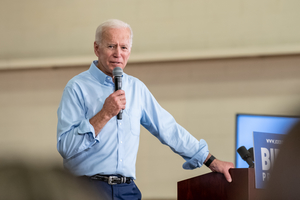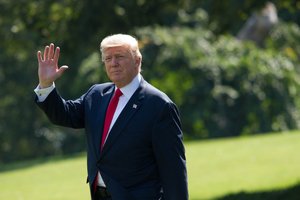SEMA News—August 2020
FROM THE HILL
2020 Countdown to Election Day
A Race for the White House Like No Other
By Eric Snyder
 The winner of the 2020 presidential election will be determined based on how the candidates fare in a handful of states, including Arizona, Florida, North Carolina, Pennsylvania, Michigan and Wisconsin. Courtesy: Nicoleta Ionescu/Shutterstock.com |
With the 2020 presidential campaign in full swing, the race is shaping up to be unlike any other in recent memory. Gone are the historical norms that we have seen in past elections, especially when it comes to the way in which candidates connect with voters.
In the aftermath of the 2016 presidential election, political pundits of all stripes tried to make sense of why their predictions were so wrong. While presidential polling numbers keep fluctuating on a daily basis, the “X” factor that will determine who controls the White House for the next four years comes down to which campaign does a better job of turning out its supporters to vote. Before jumping into the general election dynamics, it is worthwhile to take a quick look back at how we got here.
President Donald Trump never faced any real opposition during the 2020 Republican primary, as he easily defeated former Massachusetts Governor Bill Weld, who last held elected office more than 20 years ago, and radio-host-turned-one-term Congressman Joe Walsh. Rep. Walsh exited the race after receiving less than 1% of the vote during the Iowa caucuses, while Governor Weld dropped out of the race in March after President Trump secured enough delegates to clinch the Republican nomination.
Former Vice President Joe Biden faced a much more complicated path to the Democrat nomination, as he bested 28 rivals who ran for president in what was the largest field of candidates ever to compete for a party’s presidential nomination.
 After winning five of six states on March 10, Biden’s pathway to the nomination was all but secured, as Sen. Sanders posed little threat during his final few weeks in the race. Courtesy: Crush Rush/Shutterstock.com |
While Vice President Biden led national primary polls throughout 2019 by sizeable margins, his campaign’s narrative changed when the early primary and caucus results came in. Biden finished a distant fourth in the Iowa caucuses on February 3 before dropping to fifth in the New Hampshire primary, which took place only eight days later.
Pundits had all but written the former vice president’s political obituary after U.S. Senator Bernie Sanders (I-VT) won the Nevada caucus on February 22, beating the former vice president by a margin of more than two to one. However, Biden turned his campaign around with a commanding victory over Sanders in South Carolina, which also led to South Bend Mayor Pete Buttigieg and U.S. Senator Amy Klobuchar (D-MN) dropping out of the race.
Biden went on to win 10 out of 14 states on Super Tuesday, resulting in U.S. Senator Elizabeth Warren (D-MA) and former New York City Mayor Michael Bloomberg exiting the race. After then winning five of six states on March 10, Biden’s pathway to the nomination was all but secured, as Sen. Sanders posed little threat during his final few weeks in the race.
The unofficial start to the showdown between President Trump and Vice President Biden was sidelined before it ever got off the ground when the nation’s attention quickly changed to the COVID-19 crisis, which shuttered much of the country by mid-March. In addition to impacting nearly every facet of our personal and professional lives, the pandemic completely upended the presidential race, including everything from the issues that matter most to voters to the way in which the respective candidates try to connect with the American people.
 President Donald Trump never faced any real opposition during the 2020 Republican primary, as he easily defeated former Massachusetts Governor Bill Weld, who last held elected office more than 20 years ago, and radio-host-turned-one-term Congressman Joe Walsh. Courtesy: Michael Candelori/Shutterstock.com |
At press time, neither President Trump nor Vice President Biden had been able to campaign, since rallies and other traditional events were not an option due to restrictions on large public gatherings, and even the format used to officially nominate the candidates through the Republican and Democratic national conventions was in question.
While President Trump held official White House events and briefings on nearly a daily basis to highlight his administration’s work to address the COVID-19 crisis, Vice President Biden was largely relegated to communicating with his supporters and doing interviews from a studio in his house. However, as states continue to reopen, both candidates are likely to increase the amount of time they spend on the campaign trail, albeit in a modified way.
The winner of the 2020 presidential election will be determined based on how the candidates fare in a handful of states, including Arizona, Florida, North Carolina, Pennsylvania, Michigan and Wisconsin. The residents of those states will be targeted through the mail, online, and when they turn on their televisions, and the candidates and outside groups will spend considerable resources to shape the outcome of the election in those battlegrounds. Additionally, President Trump and Vice President Biden may spend a majority of their time on the campaign trail in those six states.
The race for the presidency will consume the national media’s attention, although the results of the election will also have a considerable impact on who controls both houses of Congress for the next two years. Presidential elections typically bring out a higher turnout of voters, which includes many people who are more focused on what takes place at the top of the ticket and are less likely to pay attention to the candidates running for the U.S. House of Representatives and the Senate. Accordingly, the fate of many Republican and Democratic candidates for Congress depends on how well Trump and Biden fare in their state or congressional district.
While Republicans control the Senate by a margin of 53 to 47, they are forced to defend 21 of the 33 seats up for reelection, since Republicans fared so well six years before in 2014. Based on current projections, Republicans face an uphill battle in defending Senate seats in Arizona, Colorado, North Carolina and Maine, in addition to the challenge of holding on to hotly contested races in Iowa and Georgia. Democrats will have their hands full keeping the Senate seat they hold in Alabama, and Michigan could also be a closely contested race. Meanwhile, Democrats face the challenge of protecting their 233 to 198 majority in the House, with Republicans needing to take back 18 seats to regain power.
Given the importance of the upcoming election, it is critically important that the men and women that make up the automotive specialty aftermarket make their voices heard by voting in November. The voter-information tool at www.semasan.com/semavotes provides information on each state’s voting dates and deadlines.
Election day will fall on the first day of the 2020 SEMA Show, so don’t forget to make plans to vote absentee or vote early. You can also have an impact on the electoral process by becoming SEMA PAC-approved for free at www.semapac.com. There is never any obligation to contribute to SEMA’s political action committee, although it is a valuable tool for the industry to support the car men and women in Congress who have the industry’s back.







